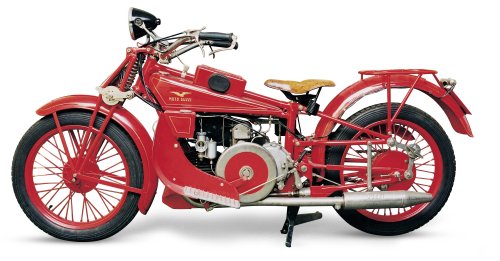
Moto Guzzi GT Norge

| Modello G.T.Norge e G.T 16 | Anno 1923-1928 |
| Motore | Quattro tempi monocilindrico orizzontale 88x82mm / 498,4cc |
| Potenza | 13CV a 3800 giri/min |
| Disposizione valvole | contrapposte-aspirazione laterale,scarico in testa |
| Comando valvole | aspiraz.diretta da punteria, scarico con asta e bilanciere |
| Accensione | a magnete tipo Bosch blindato |
| Carburatore | Amal |
| Cambio | a 3 velocità con comando manuale |
| Telaio | a doppia culla in tubi e lamiera |
| Sospensione Ant. | forcella a parallelogramma con ammortizzatori a frizione |
| Sospensione Post. | forcellone oscillante con ammortizzatori a frizione |
| Ruote | cerchi da 19x2 |
| Pneumatici | 3.50-19" |
| Velocità massima | 100 km/h |
GT
NORGE - 1928-1929
ENGLISH
The initials GT were flanked by the name Norge in celebration of the Polar Circle expedition by Carlo Guzzi and his brother Giuseppe. Like other products from Mandello, the GT 500 was distinguished by innovation. The strong point of this motorcycle, earmarked for Gran Touring, was not so much the performance levels of the engine, but its comfort. At that time torsional strength was incompatible with the presence of rear suspension and Carlo Guzzi came up with a system which led to an effective compromise. The housing for four springs was made in the front part of the frame which, by working in compression, absorbed the stress coming from the oscillating fork which they were connected to. After successful tests, this solution was then also adopted in the race bikes.
GT
NORGE“ – 1928-1929
DEUTSCH
An
das Kürzel „GT“ wurde der Name „Norge“ angehängt, um an das von Carlo
Guzzi und seinem Bruder Giuseppe durchgeführte Rennen am Polarkreis zu erinnern.
Wie andere aus den Werken Mandellos stammende Produkte, zeichnet sich auch die
GT 500 durch innovative Lösungen aus. Die Vorzüge dieses für Tourenmotorrades
liegen nicht nur in den Leistungen des Motors, sondern in der ständigen
Verbesserung des Komforts. Zu dieser Zeit schien die Torsionsfestigkeit mit der
Verwendung einer Hinterachsaufhängung unvereinbar zu sein, doch Carlo Guzzi
erfand ein System für einen wirksamen Kompromiß: Im vorderen Teil des Rahmens
wurde Platz für vier Federn gefunden, die unter Druck arbeitend die
Beanspruchung der schwingenden Gabel aufnehmen, mit der sie verbunden sind.
Später wurde diese Lösung – nachdem sie ihre Wirksamkeit bewiesen hatte –
auch im Rennsport verwendet.
GT NORGE - 1928-1929
ITALIANO
Alla sigla GT fu affiancato il nome Norge per
ricordare il raid al circolo polare effettuato da Carlo Guzzi e dal fratello
Giuseppe. Come altri prodotti usciti dagli stabilimenti di Mandello, anche la GT
500 si distingue per la presenza di soluzioni inedite. Il punto di forza di
questa moto destinata al granturismo non è tanto nelle prestazioni del motore,
ma nella ricerca del confort. A quell'epoca la rigidità torsionale era
inconciliabile con la presenza di una sospensione posteriore e Carlo Guzzi
trovò il sistema per ottenere un efficace compromesso. Nella parte anteriore
del telaio era ricavato l'alloggiamento per quattro molle che, lavorando in
compressione, assorbivano le sollecitazioni provenienti dal forcellone
oscillante al quale erano collegate. Dopo avere la sua validità, questa
soluzione fu successivamente adottata anche nelle competizioni.